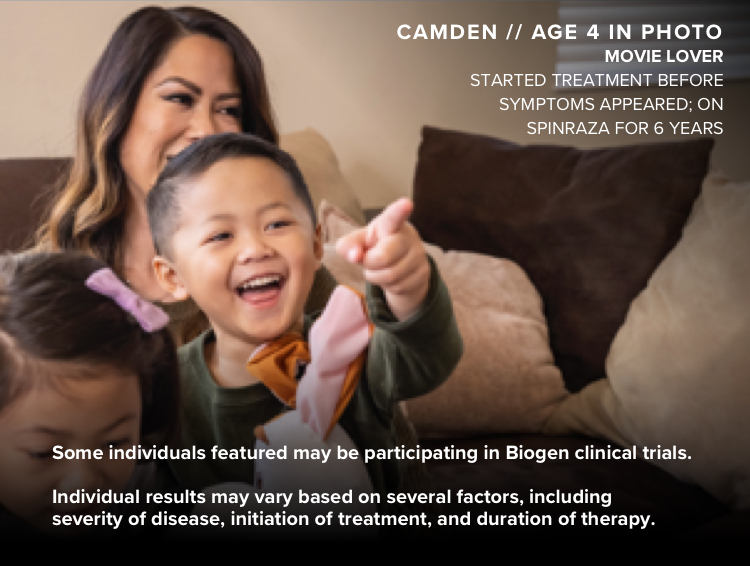WHY SPINRAZA/PRESYMPTOMATIC EFFICACY
Supportive trial: NURTURE1-3
Study: A phase 2, open-label, multicenter, multinational, single-arm trial
Treatment duration: Ongoing
Participants: 25 presymptomatic infants who were genetically diagnosed with SMA (2 SMN2 copies, n=15; 3 SMN2 copies, n=10) and were aged ≤6 weeks
Primary endpoint: Time to death or respiratory intervention
Secondary endpoints: Attainment of WHO motor milestones and change from baseline in the CHOP INTEND motor function scale
Study limitations: Small participant group size and no sham control group; CHOP INTEND score was assessed only until a participant achieved the maximum score of 64. HINE-2 score was assessed until day 778, but not at later study visits
Safety: Consistent with the SPINRAZA Prescribing Information; after a follow-up of 14 months to 5.7 years, no new safety concerns were identified and 100% (25/25) of participants had an adverse event that was mild, or moderate in severity.
WHO=World Health Organization, CHOP
INTEND=Children's Hospital of Philadelphia Infant Test
of Neuromuscular Disorders, HINE-2=Hammersmith
Infant Neurological Exam Part 2.
Participants taking SPINRAZA showed improvement at the initial interim analysis at 14 months (median 25 months, range 14-34 months)1
Primary endpoint:
100% (25/25) of infants were alive without permanent ventilation1*
84% (21/25) of infants did not require respiratory intervention2†
The majority of infants achieved the following WHO motor milestones1:
*Permanent assisted ventilation was defined as tracheostomy or ventilator support for ≥16 hours per day for >21 continuous days in the absence of an acute reversible event.1,2
†Respiratory intervention was defined as ventilation for ≥6 hours/day continuously for ≥7 days, or tracheostomy.
Majority of infants achieved major WHO motor milestones—many in time frames consistent with those without SMA2‡
Results may vary based on several factors, including severity of disease.
‡WHO MM windows of achievement were determined based on the WHO Multicenter Growth Reference Study windows of achievement in healthy children.
Well-established safety with no new concerns2
NURTURE results were consistent with safety seen in SPINRAZA pivotal studies. After a median follow-up of 4.9 years (range 3.9-5.7), 25/25 infants experienced an adverse event (any, including mild [24%], moderate [52%], severe [24%]), and no new safety concerns were identified.§
§Serious AEs (N=12) were tendon disorder, dehydration (n=1); bronchitis, choking, pneumonia, medical device change, tonsillectomy (n=1); pneumonia, tonsillectomy (n=1); upper respiratory tract infection, diarrhea (n=1); mycoplasmal pneumonia (n=1); viral upper respiratory tract infection (n=1); post lumbar puncture syndrome, abdominal distention, respiratory distress, dehydration, enterovirus infection, corona virus infection (confirmed not COVID-19), respiratory syncytial virus bronchiolitis, bacterial pneumonia, acute respiratory failure, respiratory failure, tachycardia, viral gastroenteritis, pneumonia, feeding disorder, choking (n=1); respiratory distress, respiratory syncytial virus bronchiolitis, pneumonia aspiration, pneumonia, influenza A virus positive, respiratory failure, respirovirus positive test (n=1); failure to thrive (n=1); urinary tract infection (n=1); respiratory syncytial virus infection (n=1); pyrexia, pneumococcal pneumonia, pneumonia, pseudomonal pneumonia, upper respiratory tract infection (n=1).
MM=motor milestone; SMA=spinal muscular atrophy; SMN=survival motor neuron; WHO=World Health Organization.
NURTURE study interim analysis data cut-off-date: February 15, 2021.
- One additional child achieved walking alone between the February 19, 2020 and February 15, 2021 data cuts||
- There was no loss of major motor milestones
||Caregiver-reported age at which participant first achieved WHO MM confirmed by the study site at the next study visit with a “yes” or “no” response.


“We are very, very thankful for
the advances in science.”



